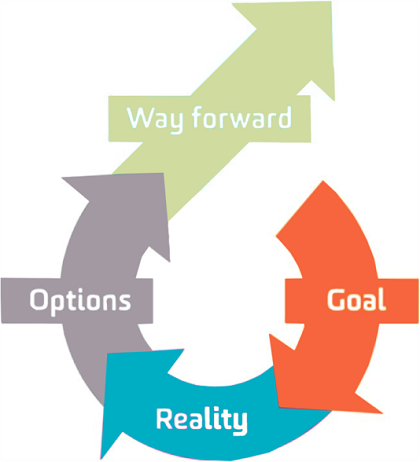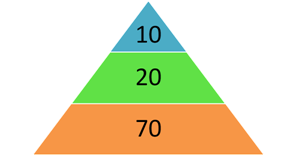One of our prime responsibilities as a manager is to grow the capability of our team members. We are also committed to giving our team members every opportunity to excel in their jobs. Council supports learning & development to ensure people perform at higher levels, improve job satisfaction and to maintain competence in fields of expertise. The following policies outline council’s commitment to learning and development: Learning & Development Policy, Learning & Development Framework, Bicultural Capability Development Plan. Learning & Development opportunities are available on StaffNet and a wide range of courses are available from the Course Library in the Learning & Development module in PeopleStreme.
Experience shows the effectiveness of a 70-20-10 approach to developing capability. The approach acknowledges that most learning (70%) occurs through experience and practice. Around 20% comes by drawing on the knowledge of others and 10% through formal learning.
You can be extremely effective in developing your team simply by harnessing the learning opportunities around you every day. Think of yourself as a sports coach. Watching people perform, identifying their development needs, putting plans in place to grow capability and working with them to review progress.
How do I diagnose training needs and create training plans?
Doctors are taught, “prescription without diagnosis is malpractice”. Before prescribing a learning and development solution, you need to thoughtfully define the development need or gap. For example, on the job training from experts in your team is usually a better (and cheaper) way to grow capability then sending someone on a course. Use the GROW approach below to systematically identify training needs and put an effective coaching plan in place. Discuss and document development priorities in the Performance Plans in PeopleStreme through the regular performance conversations you have with your team members and ensure plans are implemented.

Set a goal Start by establishing a coaching goal. Think about the outcome you want. Ask questions to clarify the goal.
- What would you like to see happen?
- What would you like to accomplish?
- What results do you want?
- What change do you want?
- What does success look like?
What is the current reality? This step helps you and the team member understand the current reality you want to change. What is happening now? Describe in terms of current approach, process, action, behaviours – not in terms of results. Ask questions to help clarify the current reality.
- What is happening now (what, who, when, how often)? What is the affect or result of this?
- What are the component parts of success here? Which are the main problems?
- What progress have you made so far?
- What have you tried already?
- What makes it difficult to do better?
- If someone said/did that to you,what would you think/feel/do?
What are the options? With a clear understanding of the current reality, you can then establish what you each might do to reach the goal. Ask questions that help explore options and generate solutions.
- What options do we have to reach our goal?
- How might they work?
- What do you think you need to do next or could you do differently?
- Who else might be able to help?
- What is the most challenging part for you?
- Evaluate the options.
- Evaluate the obstacles.
The way forward and putting the ideas into actions. The what, when, how, why and where. Ask questions that help your team member establish a clear action plan.
- This is what you / I will do starting ‘Monday’
- What do you think you need to do right now?
- How will we monitor progress?
- What obstacles are getting in the way of success?
- What resources/support support do you need?
- Complete a coaching plan
70-20-10 learning philosophy
The 70-20-10 approach acknowledges that most learning occurs through experience and practice. This approach requires that 70% of organisational learning occur through on-the-job experiences, 20% from drawing on th e knowledge of others and 10% through formal learning. It is designed to prioritise development outside classes, courses and conferences. You should use 70-20-10 every day.
e knowledge of others and 10% through formal learning. It is designed to prioritise development outside classes, courses and conferences. You should use 70-20-10 every day.
Corporate training calendar
Each year Organisational Development and Capability develop a corporate training programme. This is guided by; analysing the patterns across team member’s personal development opportunity plans (from performance conversations); policies and procedures; employment legislation changes; organisational strategies and needs. The corporate training plan is prioritised and approved by the Executive Team. Corporate training is able to be viewed and booked from the Course Library in the Learning & Development module in PeopleStreme.
Other training
In line with your learning and development budgets, you and your team members are responsible for identifying, and sourcing job specific or industry specific training (conferences, seminars, courses). If you do not have a starting point for sourcing your training requirements, Organisational Development and Capability may be able to direct you to some possible options.
Once identified, the Business Case – Learning & Development Request form needs to be completed by the team member and then signed off by the relevant Group Manager. Once approved the Learning & Development Form also has to be completed, providing registration, flight and accommodation details and both forms need to be sent to the Moana Petre and the course registration, flight and accommodation bookings will then be arranged.
Is there support for individual training?
If you have a team member wishing to enrol in a course that is relevant to their job, you can consider granting financial support and study leave. The amount of leave and financial support given will vary in relation to how useful you consider the training will be to the team member in their role.
As a general guideline,we may contribute up to 100% of total cost of fees; contribute to travel and accommodation, or time off for exams (maximum of two days per exam of half a day per paper for cadets). Team members can apply for study approval which must be approved by the Group Manager. Refer to Study Assistance in the Learning and Development Policy.
You may want to consider bonding your team member to the costs of the study if it is considered significant. The bond period can be up to a two year period and will be on a case-by-case basis. Refer to Bonding in the Learning and Development Policy.
Bonding must be negotiated with your team member before approving any study. Speak to Organisational Development and Capability for further information on bonding including drafting an agreement.
Leadership development
Our Leadership Development programme is structured to understand personal leadership potential and to build a framework for a focused organisation that enables our leaders to be aligned and achieve together. It focuses on your involvement as a leader in the wider RLC leadership community and the various meetings and communication processes that accompany these. The activities of the leadership community are supplemented by a range of learning and development activities in leadership and management development.
